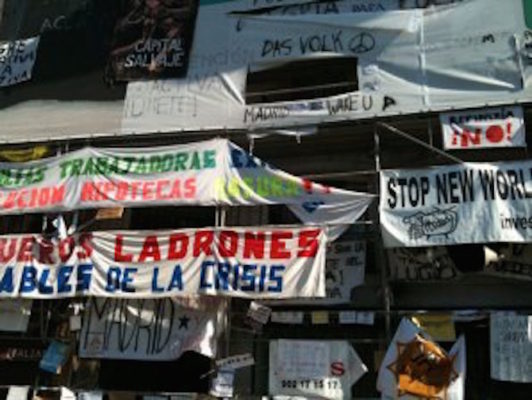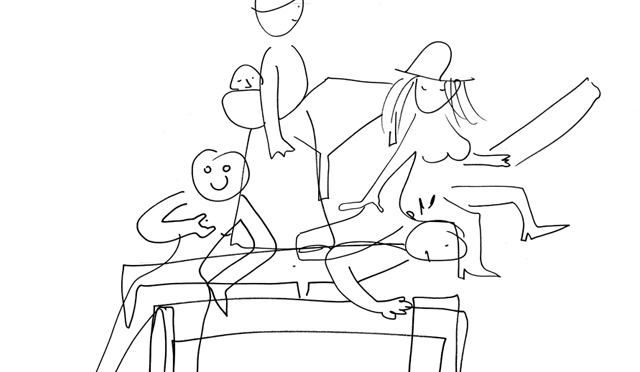Search
To search for an exact match, type the word or phrase you want in quotation marks.
A*DESK has been offering since 2002 contents about criticism and contemporary art. A*DESK has become consolidated thanks to all those who have believed in the project, all those who have followed us, debating, participating and collaborating. Many people have collaborated with A*DESK, and continue to do so. Their efforts, knowledge and belief in the project are what make it grow internationally. At A*DESK we have also generated work for over one hundred professionals in culture, from small collaborations with reviews and classes, to more prolonged and intense collaborations.
At A*DESK we believe in the need for free and universal access to culture and knowledge. We want to carry on being independent, remaining open to more ideas and opinions. If you believe in A*DESK, we need your backing to be able to continue. You can now participate in the project by supporting it. You can choose how much you want to contribute to the project.
You can decide how much you want to bring to the project.

The political changes in some Spanish cities such as Barcelona or Madrid have not sprung out of nowhere so much as respond to certain dynamics that began to arise with the movements of the Indignados who occupied the squares of many Spanish cities in 2011. Kamen Nedev, who followed all these processes very closely, wrote at the end of May (only a few days after 15M) about the questions opened up by everything that was going on and about its potential. It’s worth rereading that article now, from a future that has already responded to some of the questions but still has many others to resolve.
‘Amazement’ is the only word to describe the first impressions of the demonstrations of last 15May, and the social and political phenomenon that has continued until today. Amazed obviously were the political class amazed, that didn’t see, or didn’t want to see, in those ‘neets’ a collective of political agents to bear in mind. Even more amazed were the general press that played down the importance of a mobilization organised through social networks, with additional discomfort of days already fully taken up with an election campaign. For all of them the phenomenon has slipped through their grasp, remaining under their radars until it was just too late.
But those participating in these events are also all amazed. ‘Nobody Expects the Spanish Revolution’, declares an ingenious banner that circulated through diverse media over these days; hyperbole aside, Monty Python ought to feel proud. No, not even we expected this.
Let’s be honest, a first reading of the movement’s manifesto ‘Democracia Real Ya’ (Real Democracy NOW), even for the most predisposed and totally empathetic, generated a certain discomfort. Its demands were too vague, too abstract and uncomfortably naïve. It didn’t seem anything like a declaration that could move the masses. Nobody expected to find so many people in the demonstrations of 15M: like the last demonstrations, (last 1 May, the General Strike…) many attended with that touch of resignation of those who have nothing more to lose. Many of us also looked at the symbolic camp in the Puerta del Sol of Madrid with a pessimism charged with sympathy: it seemed a heroic, last act, beautiful but undoubtedly doomed to fail.
Even more amazing was the panorama of Sol in the early hours of the morning of Monday 16 May. There still wasn’t a ‘camp’ as such, just loads of cardboard, yellow hoardings and some blankets. But there were already five committees working in coordination every day on their respective tasks; those who arrived were directed to one or other. Each person knew they had to find a place in this organisational scheme. Where did so much organisational capacity come from? How can you arise from the amorphous organisation of the social media and establish such a well-organised structure in so little time? How can people who only know each other by their respective avatars in Twitter organise themselves so well, articulate an affective community so rapidly?
A conversation with Amador Fernández-Savater on the night of Monday 16, after which the public assembly of the Acampada Sol became a mass rally, made it all clear for me. A less abstract manifesto, a more coherent political programme, and less ambitious vindications wouldn’t have given rise to the participatory success. It had been the call’s lack of precision that had made it appeal to so many individuals from disparate social groups and ages. It had been the lack of a superior, hierarchical entity acting as the organiser that had animated so many to join in and participate actively, to feel as if the protests and the occupation of the Puerta del Sol was theirs.
In reality, what we have around us is something very distinct from political protests of the past. We are witnessing the moment when it is dawning on the Network-society the power it has to articulate political desire. Hence why nothing, not the declarations, the agency, nor the complaints, resemble what we already know. Hence why the organisational structure of this leaderless movement is the inheritor of the culture of open software: maximum opening, multiple channels of participation and interlocution, and a pragmatic and efficient organisation. Therein lies the amazement and there, in part, the fascination that it provokes.
As the Critical Art Ensemble in 1993 predicted in Electronic Civil Disobedience, the ‘squares’ of these new communities are in the Web. The spaces of participation and open debate, the public spaces, are produced increasingly in the ambit of telematics; that is from where public space in the urban environment is taken, made, and defended. Hence the hasty eviction of some 50 people from the Acampada Sol at 5 o’clock in the morning on Tuesday 17 May did nothing more than activate what is known on the Web as the Streisand effect, or the inflammatory effect: the 50 people evicted returned that very afternoon, accompanied by another 15000 demonstrators. Who filled the square and turned the Acampada Sol into a settlement, a space for the permanent production of critical discourse. Clearing the space physically turned out to be futile and counterproductive; on a symbolic level and in the social networks, Sol never stopped being ‘Acampada Sol’ for even a moment.
It will take us a long time to evaluate the full extent of the political transformations that we are going through, and urgency won’t help to realize an early reflection. But it’s evident that we are facing a total disenchantment between an evidently pro-active and politically aware population and a dysfunctional structure of political representation, totally removed from their interests. And the response is the promotion of a practice of grassroots politics, tied into the hyper-local, without losing site of the Internet. Faced with the silence and initial hostility of the official media the response is to articulate their own tactical channels of communication, linked to the social media and of a markedly distinct character. They are media where knowledge is produced by participating in the debate, not just channel hopping from an armchair.
As the Acampada Sol grew and encompassed ever more aspects of social life, the inevitable question, “What is the culture of this movement?” was formulated ever more frequently. It was an open question. Or rather, it was an open problem. On the one hand, we continue to suffer much inertia from the past, and there is a tendency to understand culture as something separate from the rest of social and political activity of a community. The first attempts to propose a line of work are still hesitant, but they are without a doubt, the seed of something important.
This doesn’t mean to say that the ‘official’ culture shouldn’t feel referred to. If we observe the evolution of the cultural institutions in Spain over the last two decades, we see that in this sector there is also dissent between institutions and official cultural policies and the agents of cultural production. Between the traditional notion of Public Cultural Service and the social production of culture that society demands today. The ‘distribution of the sensitive’ of which Rancière talks is still there, unmoveable after more than thirty years of democracy and there are even more cultural agents who are demanding a grassroots culture. The demands for transparency and interlocution launched at government of the current democratic system can equally be directed towards cultural institutions.
It would be desirable, obviously, that the institutions didn’t take so long to see what was happening around them. There are already signs of life, a desire for change and transformation: I’m thinking of the line of investigation of ‘new institutionalism’ promoted by the Department of Public Activities of the Museo Reina Sofía. But, at the same time, the endeavour to emphasise the social production of culture (ultimately, the so-called ‘educational twist’ is nothing more than an attempt to give priority to those areas of the institution that do produce knowledge) is also revealing relations of production that are totally unacceptable for a public institution. (I’m thinking of the situation of the team of education and mediation of MUSA, the DEAC, but here no one can laugh very loud). In this ambit almost everything is also still to be done.
But on the other hand one inevitable attests to the fact that the Network-society has its own culture. Not a high culture formulated by a series of institutions and a series of agents with clearly demarcated and separated roles. But yes, a rich folklore in ways of doing, stories, legends and urban myths, that transversally crosses all the cultural ambits and which has its roots in the North-American pranksters of the 60s, in the tradition of culture jamming, in the media sabotage of Luther Blissett, and the aforementioned collective practices, Critical Art Ensemble, Rtmark/YesMen, and many others that contributed to that incipient global anti-globalization movement at the end of the nineties.
Paraphrasing an epigraph in “TAZ. Temporary Autonomous Zone” by Hakim Bey, when asked them about their music, the Bushmen reply: “We don’t have musicians. Together we are the voice of the forest”.

A*DESK is a critical platform focused on publishing, training, experimentation, communication and dissemination in relation to contemporary culture and art, which is defined by transversality. The starting point is contemporary art, because that is where we come from and this awareness allows us to go much further, to incorporate other disciplines and forms of thought in order debate issues that are relevant and urgent for understanding our present.
"A desk is a dangerous place from which to watch the world" (John Le Carré)